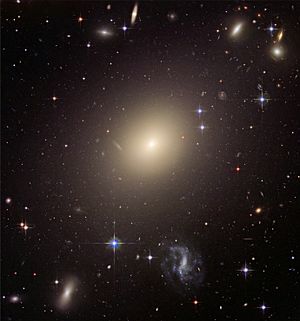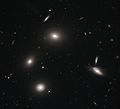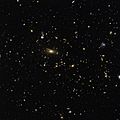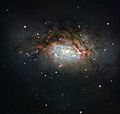Elliptical galaxy facts for kids
An elliptical galaxy is a type of galaxy that looks like a stretched-out ball or an ellipsoid. Imagine a rugby ball or a flattened sphere! These galaxies have a smooth appearance, and their brightness slowly fades from the center outwards.
In 1936, a famous astronomer named Edwin Hubble first described three main types of galaxies. Elliptical galaxies were one of them, along with spiral and lenticular galaxies.
Elliptical galaxies come in many shapes, from almost perfectly round to very flat, like a cigar. They also vary greatly in size, holding anywhere from hundreds of millions to over a trillion stars! Edwin Hubble once thought that elliptical galaxies might turn into spiral galaxies over time, but scientists later found this wasn't true. The stars in elliptical galaxies are usually much older and cooler than the stars you find in spiral galaxies, which makes them appear redder.
Contents
What Are Elliptical Galaxies Made Of?
Most elliptical galaxies are full of older, low-mass stars. They don't have much gas or dust between their stars (this is called the interstellar medium). Because of this, very few new stars are forming in these galaxies.
You'll often find many globular clusters (groups of hundreds of thousands of old stars) orbiting elliptical galaxies. Scientists believe that elliptical galaxies make up about 10–15% of the galaxies in our local neighborhood, like the Virgo Supercluster. However, they are not the most common type of galaxy in the entire universe. You usually find them close to the centers of large groups of galaxies called galaxy clusters.
"Early-Type" Galaxies
Elliptical galaxies and lenticular galaxies are sometimes called "early-type" galaxies (ETG). This name comes from their place in the Hubble sequence, which is a way astronomers classify galaxies. These types of galaxies are less common in the early Universe, meaning they are rarer in galaxies that are very far away from us.
Related pages
- IC 1101: This is one of the largest known galaxies found in the galaxy cluster called Abell 2029.
- Messier 87: A famous Galaxy in the Virgo Cluster, known for shooting out an amazing jet of plasma.
- Messier 49: A bright Galaxy also found in the Virgo Cluster.
- Messier 59: Located near Messier 60, another galaxy in the Virgo cluster.
- Abell-2261 BCG: This galaxy has one of the largest central parts (cores) of any known galaxy.
Images for kids
-
The brilliant central object is a supergiant elliptical galaxy. It's the main galaxy in a galaxy cluster called MACSJ1423.8+2404. Notice the cool effect called gravitational lensing.
See also
 In Spanish: Galaxia elíptica para niños
In Spanish: Galaxia elíptica para niños






